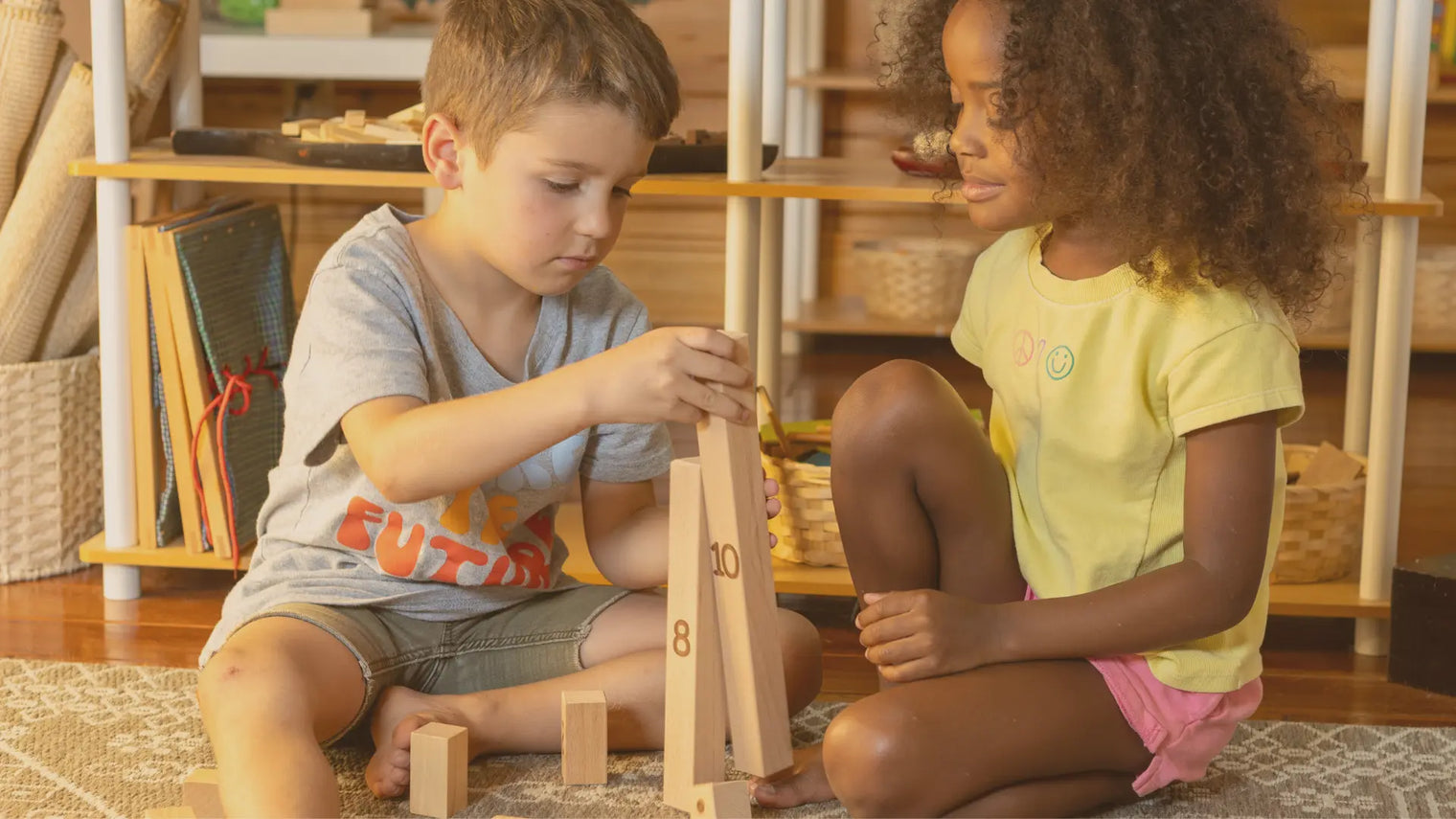Discover 20 innovative Montessori number block activities that go beyond counting. Creative math games for deeper learning and engagement.
Numbers are everywhere in a child’s world. From counting toys on the floor to noticing the digits on a clock, math is part of everyday life long before formal schooling begins. One of the most effective and hands-on ways to help children understand numbers is through Montessori number blocks.
These beautifully simple tools are designed to give kids a tactile, visual way to explore counting, addition, subtraction, and even more advanced math concepts.
At Dannico Woodworks, we believe that learning should be both meaningful and joyful. Montessori number blocks perfectly align with that philosophy—they empower kids to explore independently, make discoveries on their own, and build a strong foundation in math while having fun.
In this article, we’ll share 20 creative activities you can do with Montessori number blocks.
Each activity is designed to be simple, engaging, and developmentally supportive.
Whether you’re working with a preschooler just learning to count or an older child exploring multiplication, these ideas will bring math to life in your home or classroom.
1. Counting Towers
Stack blocks in order from one to ten. As your child builds, encourage them to say the number out loud. This visual and physical activity strengthens number recognition and sequencing.
2. Number Matching
Write numbers on cards and have your child match each card with the corresponding block. This bridges the gap between abstract symbols and physical quantities.
3. Simple Addition
Give your child two smaller blocks and ask them to combine them to make a larger block. For example, a block of 2 and a block of 3 can be placed next to the block of 5. This shows addition visually and concretely.
4. Subtraction Stories
Start with a longer block (say 8). Remove a smaller block (say 3). Then ask your child: “How many are left?” The physical removal helps subtraction feel less abstract.
5. Pattern Building
Encourage your child to create repeating patterns using blocks (e.g., 1-2-1-2 or 3-4-3-4). This helps develop recognition of sequences and early algebraic thinking.
6. Measuring with Blocks
Use the blocks like a ruler. For example, measure how many blocks long a toy car is. Kids learn about measurement, comparison, and length in a playful way.
7. Block Races
Set a timer and see how quickly your child can arrange the blocks in numerical order. Make it fun by cheering them on and letting them “beat their best time.”
8. Odd and Even Sort
Have your child separate the blocks into odd and even numbers. This introduces important number concepts in a hands-on way.
9. Number Tracing
Place paper over a block and let your child trace around it. Write the number on the traced shape to reinforce the connection between form and symbol.
10. Greater Than, Less Than
Choose two blocks and ask which one is “bigger.” This builds an early understanding of comparison and number value.
11. Storytelling with Numbers
Create mini math stories using blocks. For example: “You have 4 apples. I give you 2 more. How many do you have now?” Children love stories, and adding blocks brings the story to life.
12. Multiplication Building
Lay out groups of smaller blocks to show multiplication. For example, three groups of 2 equals a block of 6. This makes multiplication concrete and visual.
13. Number Hunt
Hide blocks around the room and ask your child to find them in order. This activity combines movement, play, and learning.
14. Symmetry Play
Encourage your child to build symmetrical designs with the blocks. This not only reinforces math but also sparks creativity and balance recognition.
15. Ten Frame Fun
Use the blocks to create a simple ten frame. Ask your child to fill it with combinations that add up to 10, a core skill in early math learning.
16. Graphing with Blocks
Stand the blocks upright and use them to create a simple bar graph. For example, graph how many red, blue, and green toys are in the playroom.
17. Fraction Play
Use larger blocks to represent “wholes” and smaller ones as “parts.” For example, show that two blocks of 5 equal one block of 10. This gently introduces fractions.
18. Domino Effect
Line up the blocks and let your child knock them down. Count how many blocks topple. This blends play with math practice.
19. Challenge Builds
Ask your child to “build the number 12” in as many ways as possible (e.g., 10 + 2, 6 + 6, 7 + 5). This encourages flexible math thinking.
20. Free Play Exploration
Sometimes the best learning comes from simply letting kids explore. Give them the blocks without instructions and watch how they experiment with numbers, shapes, and balance.
Why Montessori Number Blocks Work So Well
Montessori learning emphasizes hands-on discovery. Instead of memorizing facts, children use their senses to explore concepts.
Number blocks allow kids to see, touch, and manipulate math problems. This makes abstract ideas concrete, which is especially powerful in early childhood.
At Dannico Woodworks, we design with this same philosophy in mind. Just as Montessori materials support independence and creativity, our furniture is built to encourage children’s growth and exploration in safe, practical ways.
From learning towers to play tables, our goal is to create environments that empower children to learn naturally.
FAQs
At what age can my child start using Montessori number blocks?
Most children can begin using them around age 3, but older kids also benefit as they move into more complex math concepts.
Do Montessori number blocks replace worksheets or flashcards?
They don’t replace them, but they make learning much richer. Blocks give kids a concrete foundation, which makes later abstract practice easier.
How do I know if my child is learning or just playing?
Play is learning. When your child is stacking, comparing, or counting blocks, they’re developing math skills naturally.
Can I make my own number blocks?
Yes, though buying well-crafted ones ensures durability and precision. At Dannico Woodworks, we value craftsmanship and safety, so you can trust the materials your child handles every day.
Further Resources
- American Montessori Society – Montessori Math Overview
- Montessori at Home: Math Activities
- Parenting books on Montessori philosophy, such as The Montessori Toddler by Simone Davies.
Conclusion
Montessori number blocks aren’t just math tools—they’re stepping stones to confidence, independence, and creativity.
When children use their hands to explore numbers, they’re building a lifelong love for learning.
At Dannico Woodworks, we share the same belief: that kids deserve environments where they can grow, thrive, and discover the world for themselves. Montessori number blocks fit beautifully into that vision.
So here’s the question: Which of these activities will you try first with your child, and how will you make number learning part of your everyday play?

